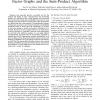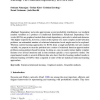483 search results - page 1 / 97 » Learning Relational Sum-Product Networks |
CORR
2012
Springer
12 years 2 days ago
2012
Springer
The key limiting factor in graphical model inference and learning is the complexity of the partition function. We thus ask the question: what are the most general conditions under...
INFOCOM
2007
IEEE
13 years 10 months ago
2007
IEEE
— Loss networks provide a powerful tool for the analysis and design of many communication and networking systems. It is well known that a large number of loss networks have produ...
ECAI
2010
Springer
13 years 1 months ago
2010
Springer
Abstract. Statistical relational models, such as Markov logic networks, seek to compactly describe properties of relational domains by representing general principles about objects...
ICMLA
2009
13 years 2 months ago
2009
Languages that combine predicate logic with probabilities are needed to succinctly represent knowledge in many real-world domains. We consider a formalism based on universally qua...
ML
2012
ACM
11 years 12 months ago
2012
ACM
Dependency networks approximate a joint probability distribution over multiple random variables as a product of conditional distributions. Relational Dependency Networks (RDNs) are...


